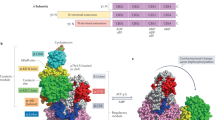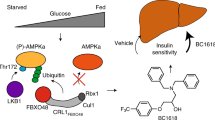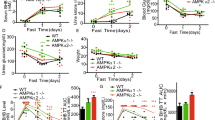Abstract
The obesity epidemic has led to an increased incidence of nonalcoholic fatty liver disease (NAFLD) and type 2 diabetes. AMP-activated protein kinase (Ampk) regulates energy homeostasis and is activated by cellular stress, hormones and the widely prescribed type 2 diabetes drug metformin1,2. Ampk phosphorylates mouse acetyl-CoA carboxylase 1 (Acc1; refs. 3,4) at Ser79 and Acc2 at Ser212, inhibiting the conversion of acetyl-CoA to malonyl-CoA. The latter metabolite is a precursor in fatty acid synthesis5 and an allosteric inhibitor of fatty acid transport into mitochondria for oxidation6. To test the physiological impact of these phosphorylation events, we generated mice with alanine knock-in mutations in both Acc1 (at Ser79) and Acc2 (at Ser212) (Acc double knock-in, AccDKI). Compared to wild-type mice, these mice have elevated lipogenesis and lower fatty acid oxidation, which contribute to the progression of insulin resistance, glucose intolerance and NAFLD, but not obesity. Notably, AccDKI mice made obese by high-fat feeding are refractory to the lipid-lowering and insulin-sensitizing effects of metformin. These findings establish that inhibitory phosphorylation of Acc by Ampk is essential for the control of lipid metabolism and, in the setting of obesity, for metformin-induced improvements in insulin action.
This is a preview of subscription content, access via your institution
Access options
Subscribe to this journal
Receive 12 print issues and online access
$209.00 per year
only $17.42 per issue
Buy this article
- Purchase on Springer Link
- Instant access to full article PDF
Prices may be subject to local taxes which are calculated during checkout




Similar content being viewed by others
References
Kahn, B.B., Alquier, T., Carling, D. & Hardie, D.G. AMP-activated protein kinase: ancient energy gauge provides clues to modern understanding of metabolism. Cell Metab. 1, 15–25 (2005).
Long, Y.C. & Zierath, J.R. AMP-activated protein kinase signaling in metabolic regulation. J. Clin. Invest. 116, 1776–1783 (2006).
Carlson, C.A. & Kim, K.H. Regulation of hepatic acetyl coenzyme A carboxylase by phosphorylation and dephosphorylation. J. Biol. Chem. 248, 378–380 (1973).
Carling, D., Zammit, V.A. & Hardie, D.G. A common bicyclic protein kinase cascade inactivates the regulatory enzymes of fatty acid and cholesterol biosynthesis. FEBS Lett. 223, 217–222 (1987).
Wakil, S.J., Stoops, J.K. & Joshi, V.C. Fatty acid synthesis and its regulation. Annu. Rev. Biochem. 52, 537–579 (1983).
McGarry, J.D., Leatherman, G.F. & Foster, D.W. Carnitine palmitoyltransferase I. The site of inhibition of hepatic fatty acid oxidation by malonyl-CoA. J. Biol. Chem. 253, 4128–4136 (1978).
Harada, N. et al. Hepatic de novo lipogenesis is present in liver-specific ACC1-deficient mice. Mol. Cell Biol. 27, 1881–1888 (2007).
Mao, J. et al. Liver-specific deletion of acetyl-CoA carboxylase 1 reduces hepatic triglyceride accumulation without affecting glucose homeostasis. Proc. Natl. Acad. Sci. USA 103, 8552–8557 (2006).
Abu-Elheiga, L., Matzuk, M.M., Abo-Hashema, K.A. & Wakil, S.J. Continuous fatty acid oxidation and reduced fat storage in mice lacking acetyl-CoA carboxylase 2. Science 291, 2613–2616 (2001).
Hoehn, K.L. et al. Acute or chronic upregulation of mitochondrial fatty acid oxidation has no net effect on whole-body energy expenditure or adiposity. Cell Metab. 11, 70–76 (2010).
Olson, D.P., Pulinilkunnil, T., Cline, G.W., Shulman, G.I. & Lowell, B.B. Gene knockout of Acc2 has little effect on body weight, fat mass, or food intake. Proc. Natl. Acad. Sci. USA 107, 7598–7603 (2010).
Choi, C.S. et al. Continuous fat oxidation in acetyl-CoA carboxylase 2 knockout mice increases total energy expenditure, reduces fat mass, and improves insulin sensitivity. Proc. Natl. Acad. Sci. USA 104, 16480–16485 (2007).
Munday, M.R., Campbell, D.G., Carling, D. & Hardie, D.G. Identification by amino acid sequencing of three major regulatory phosphorylation sites on rat acetyl-CoA carboxylase. Eur. J. Biochem. 175, 331–338 (1988).
Savage, D.B. et al. Reversal of diet-induced hepatic steatosis and hepatic insulin resistance by antisense oligonucleotide inhibitors of acetyl-CoA carboxylases 1 and 2. J. Clin. Invest. 116, 817–824 (2006).
Erion, D.M. & Shulman, G.I. Diacylglycerol-mediated insulin resistance. Nat. Med. 16, 400–402 (2010).
Samuel, V.T. et al. Inhibition of protein kinase Cepsilon prevents hepatic insulin resistance in nonalcoholic fatty liver disease. J. Clin. Invest. 117, 739–745 (2007).
Yu, C. et al. Mechanism by which fatty acids inhibit insulin activation of insulin receptor substrate-1 (IRS-1)-associated phosphatidylinositol 3-kinase activity in muscle. J. Biol. Chem. 277, 50230–50236 (2002).
Chibalin, A.V. et al. Downregulation of diacylglycerol kinase δ contributes to hyperglycemia-induced insulin resistance. Cell 132, 375–386 (2008).
Hirosumi, J. et al. A central role for JNK in obesity and insulin resistance. Nature 420, 333–336 (2002).
O'Neill, H.M. et al. AMP-activated protein kinase (AMPK) β1β2 muscle null mice reveal an essential role for AMPK in maintaining mitochondrial content and glucose uptake during exercise. Proc. Natl. Acad. Sci. USA 108, 16092–16097 (2011).
Foretz, M. et al. Metformin inhibits hepatic gluconeogenesis in mice independently of the LKB1/AMPK pathway via a decrease in hepatic energy state. J. Clin. Invest. 120, 2355–2369 (2010).
Viollet, B. et al. Cellular and molecular mechanisms of metformin: an overview. Clin. Sci. (Lond.) 122, 253–270 (2012).
Zhou, G. et al. Role of AMP-activated protein kinase in mechanism of metformin action. J. Clin. Invest. 108, 1167–1174 (2001).
Miller, R.A. et al. Biguanides suppress hepatic glucagon signalling by decreasing production of cyclic AMP. Nature 494, 256–260 (2013).
Musso, G., Cassader, M., Rosina, F. & Gambino, R. Impact of current treatments on liver disease, glucose metabolism and cardiovascular risk in non-alcoholic fatty liver disease (NAFLD): a systematic review and meta-analysis of randomised trials. Diabetologia 55, 885–904 (2012).
Bailey, C.J. & Mynett, K.J. Insulin requirement for the antihyperglycaemic effect of metformin. Br. J. Pharmacol. 111, 793–796 (1994).
Bailey, C.J. & Turner, R.C. Metformin. N. Engl. J. Med. 334, 574–579 (1996).
Gómez-Sámano, M.Á. et al. Metformin and improvement of the hepatic insulin resistance index independent of anthropometric changes. Endocr. Pract. 18, 8–16 (2012).
Natali, A. & Ferrannini, E. Effects of metformin and thiazolidinediones on suppression of hepatic glucose production and stimulation of glucose uptake in type 2 diabetes: a systematic review. Diabetologia 49, 434–441 (2006).
Cool, B. et al. Identification and characterization of a small molecule AMPK activator that treats key components of type 2 diabetes and the metabolic syndrome. Cell Metab. 3, 403–416 (2006).
Li, Y. et al. AMPK phosphorylates and inhibits SREBP activity to attenuate hepatic steatosis and atherosclerosis in diet-induced insulin-resistant mice. Cell Metab. 13, 376–388 (2011).
Foretz, M., Carling, D., Guichard, C., Ferre, P. & Foufelle, F. AMP-activated protein kinase inhibits the glucose-activated expression of fatty acid synthase gene in rat hepatocytes. J. Biol. Chem. 273, 14767–14771 (1998).
Lalau, J.D., Lemaire-Hurtel, A.S. & Lacroix, C. Establishment of a database of metformin plasma concentrations and erythrocyte levels in normal and emergency situations. Clin. Drug Investig. 31, 435–438 (2011).
Owen, M.R., Doran, E. & Halestrap, A.P. Evidence that metformin exerts its anti-diabetic effects through inhibition of complex 1 of the mitochondrial respiratory chain. Biochem. J. 348, 607–614 (2000).
Wilcock, C. & Bailey, C.J. Accumulation of metformin by tissues of the normal and diabetic mouse. Xenobiotica 24, 49–57 (1994).
Clark, J.M., Brancati, F.L. & Diehl, A.M. Nonalcoholic fatty liver disease. Gastroenterology 122, 1649–1657 (2002).
He, L. et al. Metformin and insulin suppress hepatic gluconeogenesis through phosphorylation of CREB binding protein. Cell 137, 635–646 (2009).
Turban, S. et al. Defining the contribution of AMP-activated protein kinase (AMPK) and protein kinase C (PKC) in regulation of glucose uptake by metformin in skeletal muscle cells. J. Biol. Chem. 287, 20088–20099 (2012).
Dzamko, N. et al. AMPK β1 deletion reduces appetite, preventing obesity and hepatic insulin resistance. J. Biol. Chem. 285, 115–122 (2010).
Steinberg, G.R. et al. Whole body deletion of AMP-activated protein kinase β2 reduces muscle AMPK activity and exercise capacity. J. Biol. Chem. 285, 37198–37209 (2010).
Ussher, J.R. et al. Stimulation of glucose oxidation protects against acute myocardial infarction and reperfusion injury. Cardiovasc. Res. 94, 359–369 (2012).
Galic, S. et al. Hematopoietic AMPK β1 reduces mouse adipose tissue macrophage inflammation and insulin resistance in obesity. J. Clin. Invest. 121, 4903–4915 (2011).
Schertzer, J.D. et al. NOD1 activators link innate immunity to insulin resistance. Diabetes 60, 2206–2215 (2011).
Steele, R. Influences of glucose loading and of injected insulin on hepatic glucose output. Ann. NY Acad. Sci. 82, 420–430 (1959).
Preiss, J. et al. Quantitative measurement of sn-1,2-diacylglycerols present in platelets, hepatocytes, and ras- and sis-transformed normal rat kidney cells. J. Biol. Chem. 261, 8597–8600 (1986).
Acknowledgements
We thank C. Saab from the McMaster Centre for Translational Imaging for completing the computed tomography analysis and S. Stypa and E. Day for technical assistance. This study was supported by grants and fellowships from the Australian Research Council and the Commonwealth Scientific and Industrial Research Organisation (B.E.K.), the Australian National Health and Medical Research Council (B.E.K., B.J.v.D. and G.R.S.), the Canadian Diabetes Association (G.R.S., J.R.B.D. and J.D.S.) and the Canadian Institutes of Health Research (CIHR) (G.R.S. and J.R.B.D.) and was supported in part by the Victorian Government Operational Infrastructure Support Program (B.E.K.) and the Canadian Foundation for Innovation (G.R.S.). M.D.F. is supported by a CIHR Banting Postdoctoral Fellowship, J.D.S. is supported by a Canadian Diabetes Association Scholar Award and G.R.S. holds a Canada Research Chair in Metabolism and Obesity.
Author information
Authors and Affiliations
Contributions
M.D.F., S.G., B.E.K. and G.R.S. designed the study. M.D.F., S.G., K.M., S.S., R.J.F. and R.P. performed in vivo experiments. M.D.F., S.G. and J.D.S. performed primary hepatocyte experiments. S.G., Z.-P.C. performed Acc activity assays and M.O. performed mass spectrometry experiments. H.M.O. performed fatty acid oxidation in isolated skeletal muscle. T.P. and J.R.B.D. measured tissue malonyl-CoA content. D.G.H. contributed Acc antibodies for activity assays and helpful comments regarding the manuscript. B.J.v.D., S.L.M., B.E.K. and G.R.S. were involved in generating the knock-in mice. M.D.F. and G.R.S. wrote the manuscript.
Corresponding author
Ethics declarations
Competing interests
The authors declare no competing financial interests.
Supplementary information
Supplementary Text and Figures
Supplementary Figures 1-8 (PDF 789 kb)
Rights and permissions
About this article
Cite this article
Fullerton, M., Galic, S., Marcinko, K. et al. Single phosphorylation sites in Acc1 and Acc2 regulate lipid homeostasis and the insulin-sensitizing effects of metformin. Nat Med 19, 1649–1654 (2013). https://doi.org/10.1038/nm.3372
Received:
Accepted:
Published:
Issue Date:
DOI: https://doi.org/10.1038/nm.3372
This article is cited by
-
The role of anti-diabetic drugs in NAFLD. Have we found the Holy Grail? A narrative review
European Journal of Clinical Pharmacology (2024)
-
The mechanism of oleic acid inhibiting platelet activation stimulated by collagen
Cell Communication and Signaling (2023)
-
Liraglutide attenuates type 2 diabetes mellitus-associated non-alcoholic fatty liver disease by activating AMPK/ACC signaling and inhibiting ferroptosis
Molecular Medicine (2023)
-
Nutrient-sensing mTORC1 and AMPK pathways in chronic kidney diseases
Nature Reviews Nephrology (2023)
-
New insights into activation and function of the AMPK
Nature Reviews Molecular Cell Biology (2023)



